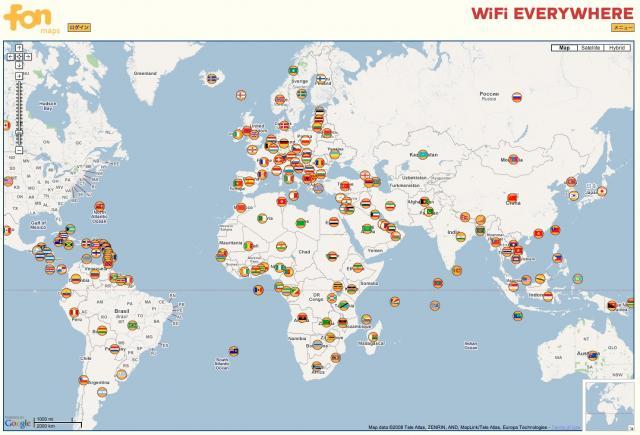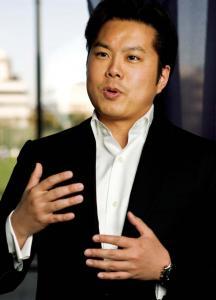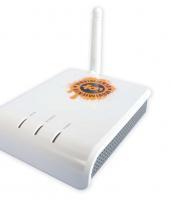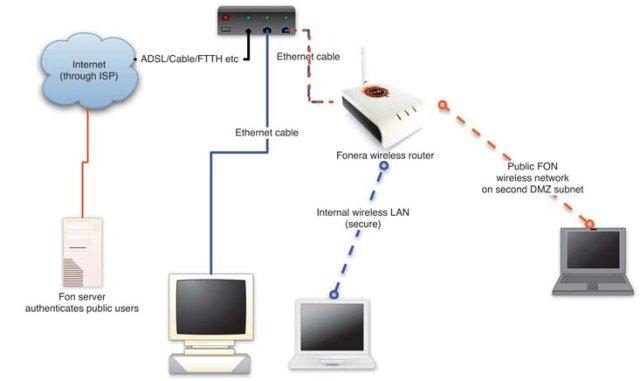CEO Interview: Junichi Fujimoto, FON Japan
By Hugh Ashton
Smaller devices incorporating wireless networking are proliferating—not just computers, but phones, PDAs and hand-held gaming machines are using the Internet to send and receive data at high speed. Areas of dense population, such as Japanese cities, would seem ideal for these networks which have limitations on the area covered by each base station, but on the other hand, setting up the infrastructure for such ubiquitous coverage would seem to be a prohibitively expensive operation.
It occurred to Martin Varsavsky, an Argentinean entrepreneur (and philanthropist) with experience in telecoms and networking, that one way of overcoming this problem was to allow the users themselves to set up and maintain the nodes of the network (already connected to the Internet through commercial ISPs) in return for being allowed to use the other users’ nodes, and thus the idea of FON as a global shared community wireless network was born.
 The FON WiFi network extends all over the world
The FON WiFi network extends all over the world
Starting in Europe, FON has now spread to Japan, through the intermediary of Junichi Fujimoto, the first president and representative director of livedoor, and a strong advocate of consumer empowerment via the Web. Although livedoor acquired a bad reputation in recent years through its stock-manipulation antics, the original Livedoor, as set up by Fujimoto before his departure from the company, was a free Internet service designed to open the doors of the Web to ordinary Japanese people. At a time when online time was typically being rationed by Internet service providers (ISPs), this was a bold and liberating step. Fujimoto talked to J@pan Inc about his philosophy, and what he sees for the future with his latest WiFi project, FON Japan.
Can we start at the beginning, when you started livedoor?
I was actually still a college student in those days [1998]. I felt that the Internet should be available to everyone for free, and that the best way to go about this was by starting up a free ISP. I’d seen this in Boston as a student, and I came back to Japan, and saw people paying lots of money for Internet access. I worked with Keith Davis and many other people bringing Extreme Network from the UK and then forming Livedoor. Actually, even then I was interested in wireless networking, though it was a technology in its infancy in those days, but a free ISP seemed like a good and workable idea to me. Livedoor was designed to open the door to the Internet for everyone, hence the name.
 Junichi Fujimoto, CEO, FON Japan
Junichi Fujimoto, CEO, FON Japan
What was the business model?
Partly advertising, but MCI and Japan Telecom were keen to get a slice of the Japanese telecom carrier pie and were prepared to return part of the connection fees they collected—it was a complicated system. Remember that the telecoms market in Japan at that time was really heavily regulated—the market’s changed substantially now, though, at least partly due to the efforts of some individuals who were around at that time, and things are a lot easier now. Anyway, we managed to raise US$33 million in six months through the offices of HSBC and Newbridge Capital and others. Crazy times! We started with Japanese management that we’d head-hunted from other places and when Mr Sakito, whom we’d brought in from AOL, took over from me as CEO (actually, I was still a student), I left Livedoor. Incidentally, I’d like to make it clear that this was long before the management that created all the recent scandals moved in!
 Wireless Router
Wireless Router
And then?
I started a company in about 2000 which was called eZuz [pronounced ee-zee-use] which provided consumer price comparisons. The company listed in August 2006. I was interested in moving into e-commerce and allowing the customer to bypass the pricing structures and the controlled market imposed by the larger retailers. I’ve always been on the consumer’s side of things, I suppose, and I wanted the consumer to be able to have a wider choice than just the major retail chains. Our idea was to aggregate prices from retailers throughout Japan into a database which customers could search for the best deal in terms of prices or delivery services, no matter what the size of the store. It’s something that you can really only do online, and it really was the right model for the time. It helped to level the playing field for the smaller stores, and so we think that this sort of thing can help the economy as a whole. We raised about US$10 million from various venture capital sources for this one, and this was one of the first comparison shopping sites of its kind in Japan.
What about FON?
This is interesting—it goes back to what I wanted in terms of an open Internet with ‘power to the people.’ After a few years that I spent on various consulting projects following eZuz, long-time mentor Kaoru Hayashi, who is the CEO and President of Digital Garage, introduced me to Martin Varsavsky, the founder of FON, and it took him and me all of 30 minutes to shake hands and decide that we should work together. His idea, after he’d seen all the closed secure WiFi networks all over the world, was to leverage existing installed network components to set up an open network using existing technology—rather than spending a lot of money setting up an expensive Wimax or the infrastructure for whatever networking solution looks as though it may be feasible in a few years’ time. Other people seem to agree with this business model; Google, Skype, eBay, BT for example, as well as Sequoia Capital and Index Ventures have invested in FON, and Digital Garage, Itochu and Excite Japan have invested in Japan. It’s not just some hippy dream!

How does it work?
You sign up as a member of the FON global network (a ‘Fonero’), and you can buy one of our very reasonably priced wireless routers. These can provide you with two networks: one private, to use inside your home; and a second one, open to any member of the FON community. These networks are separate from each other, so your home network security isn’t compromised. We put the whole thing in a professional package, and we’ve made it as easy to set up as possible— you don’t have to be a technical wizard to set it up or use it. Actually, when you think about it, it’s a bit like the concept of Web 2.0 where the users themselves create and maintain the content. This is the same sort of thing, but applied to infrastructure.
What about the terms and conditions imposed by ISPs?
We’ve had no “cease and desist” orders from ISPs’ lawyers, if that’s what you mean. Actually, the FON group has signed deals with major ISPs in Europe: British Telecom in the UK and with Neuf Cegetel in France, whereby the routers supplied by these ISPs can be configured as FON routers if the customer wants. They seem to realise that sharing bandwidth is the way to go. And that’s not just happening in Europe—many ISPs we talk to here in Japan are interested, and we’re talking about revenue sharing models with them.
Revenue from where?
We’re not making money off the routers [the basic wireless router sells for ¥1,980], but visitors to the FON network can buy a US$3 24-hour pass through our website. All they have to do is to set their access point to a public FON point [any WiFi network named FON underscore anything, such as FON_AP, is a public FON access point] and open their browsers. They’ll be redirected to the FON site, where they can buy the pass online. This is really good for people visiting Japan who don’t want to sign a long-term contract with a telco provider. Of course, anyone who is already a FON member can use these FON points for free.
How many members and FON Spots are there in Japan?
there’s a big jump in the number of WiFi devices — not just computers
56,441 Foneros in Japan, and 31,585 FON Spots as of the beginning of February 2008. But the number’s growing all the time—there’s a big jump in the number of WiFi devices— not just computers, but also the Nintendo Wii, game consoles, the Apple iPhone and iPod Touch, other cellphones, the new MacBook Air which has no built-in wired Ethernet port, Skype clients on PlayStation Portables, etc. Tsukumo [an electronics retailer] actually bundled our router with the iPod Touch in a special promotion! We see many people using FON Spots, maybe not as their primary business wireless connection, but for the WiFi devices that aren’t computers that are coming on the market.
And the future?
Wait and see! But I can tell you that I was very pleased to announce the merging of the Livedoor and FON networks on February 4 this year. This represents something I wanted to do right from the beginning when we started FON Japan, that is, to open up the Internet again, which was my original vision and dream back in the 90s. This expands Foneros’ choices within central Tokyo very considerably—right now, within the Yamanote loop [central Tokyo], Foneros can enjoy free coverage in 80% of this area—that’s another 2,200 FON Spots we’ve added! And to celebrate this new alliance, until the beginning of April, we’re actually going to waive the US$3 visitor fee. There may also be some interesting developments just over the horizon with other players. We believe that this user-created wireless mesh will become perceived as a service like Gmail or one of the free Web mail services that just becomes a transparent part of the Internet infrastructure for everyone. All part of my history of bringing choice to ordinary people, I suppose.
Contact details:
FON Japan KK
Mori Tower RoP 1303
Holland Hills
5-11-7 Toranomon
Minato-Ku, Tokyo
105-0001
www.fon.com/jp





